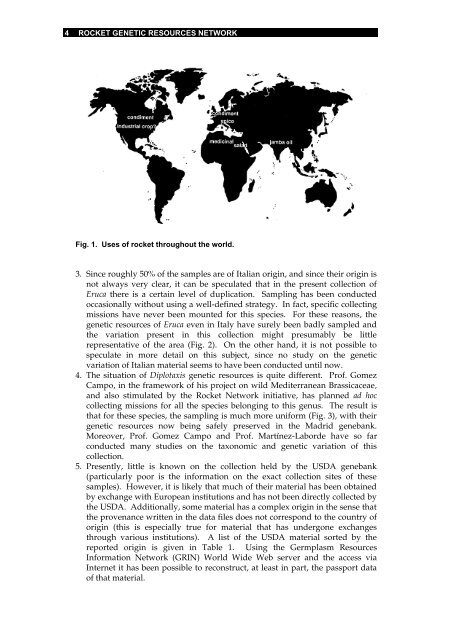Rocket: a Mediterranean crop for the world - Bioversity International
Rocket: a Mediterranean crop for the world - Bioversity International
Rocket: a Mediterranean crop for the world - Bioversity International
Create successful ePaper yourself
Turn your PDF publications into a flip-book with our unique Google optimized e-Paper software.
4<br />
ROCKET GENETIC RESOURCES NETWORK<br />
Fig. 1. Uses of rocket throughout <strong>the</strong> <strong>world</strong>.<br />
3. Since roughly 50% of <strong>the</strong> samples are of Italian origin, and since <strong>the</strong>ir origin is<br />
not always very clear, it can be speculated that in <strong>the</strong> present collection of<br />
Eruca <strong>the</strong>re is a certain level of duplication. Sampling has been conducted<br />
occasionally without using a well-defined strategy. In fact, specific collecting<br />
missions have never been mounted <strong>for</strong> this species. For <strong>the</strong>se reasons, <strong>the</strong><br />
genetic resources of Eruca even in Italy have surely been badly sampled and<br />
<strong>the</strong> variation present in this collection might presumably be little<br />
representative of <strong>the</strong> area (Fig. 2). On <strong>the</strong> o<strong>the</strong>r hand, it is not possible to<br />
speculate in more detail on this subject, since no study on <strong>the</strong> genetic<br />
variation of Italian material seems to have been conducted until now.<br />
4. The situation of Diplotaxis genetic resources is quite different. Prof. Gomez<br />
Campo, in <strong>the</strong> framework of his project on wild <strong>Mediterranean</strong> Brassicaceae,<br />
and also stimulated by <strong>the</strong> <strong>Rocket</strong> Network initiative, has planned ad hoc<br />
collecting missions <strong>for</strong> all <strong>the</strong> species belonging to this genus. The result is<br />
that <strong>for</strong> <strong>the</strong>se species, <strong>the</strong> sampling is much more uni<strong>for</strong>m (Fig. 3), with <strong>the</strong>ir<br />
genetic resources now being safely preserved in <strong>the</strong> Madrid genebank.<br />
Moreover, Prof. Gomez Campo and Prof. Martínez-Laborde have so far<br />
conducted many studies on <strong>the</strong> taxonomic and genetic variation of this<br />
collection.<br />
5. Presently, little is known on <strong>the</strong> collection held by <strong>the</strong> USDA genebank<br />
(particularly poor is <strong>the</strong> in<strong>for</strong>mation on <strong>the</strong> exact collection sites of <strong>the</strong>se<br />
samples). However, it is likely that much of <strong>the</strong>ir material has been obtained<br />
by exchange with European institutions and has not been directly collected by<br />
<strong>the</strong> USDA. Additionally, some material has a complex origin in <strong>the</strong> sense that<br />
<strong>the</strong> provenance written in <strong>the</strong> data files does not correspond to <strong>the</strong> country of<br />
origin (this is especially true <strong>for</strong> material that has undergone exchanges<br />
through various institutions). A list of <strong>the</strong> USDA material sorted by <strong>the</strong><br />
reported origin is given in Table 1. Using <strong>the</strong> Germplasm Resources<br />
In<strong>for</strong>mation Network (GRIN) World Wide Web server and <strong>the</strong> access via<br />
Internet it has been possible to reconstruct, at least in part, <strong>the</strong> passport data<br />
of that material.

















